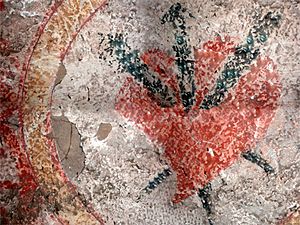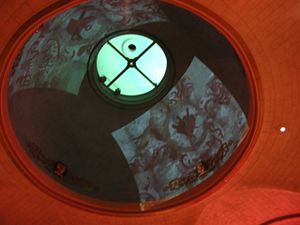Mission Dolores mural facts for kids
The Mission Dolores mural is an amazing 18th-century artwork. You can find it inside the Mission San Francisco de Asís. This mission is the oldest building still standing in San Francisco. In 1791, the Ohlone people painted this mural. They were Native Americans from the San Francisco Bay area. They worked for the church and painted the mural on the main wall of the church.
Just five years later, a large altarpiece called a reredos was built. It stood right in front of the mural. This hid the mural for over 200 years! The mural stayed mostly unseen. It slowly decayed, but was also protected from light and moisture behind the reredos.
In the 2000s, an archaeologist named Eric Blind and artist Ben Wood used computers to make digital copies of the mural. This let everyone see it for the first time! The mural is painted on plaster. It has cool abstract patterns and Christian pictures. The colors are earthy, like ochre, white, red, yellow, black, and blue/grey. This mural is very important historically. It comes from the early time of the Spanish missions in California (1769–1833). Many people think it is "the best-preserved example of art from the period of first contact with Europeans."
Contents
What the Mural Looks Like
Building the adobe walls for the mission church started in 1788. Native workers made 36,000 bricks! By 1790, the walls were finished. They were plastered and painted white. The mural was most likely painted between then and August 2, 1791. That was when the church was officially opened.
The mural covers the whole back wall of the church. It is behind the old wooden altar. The mural is 22 feet tall and 20 feet wide. It also has two special spots for statues. In 1796, a grand wooden altarpiece called a reredos covered the mural. This reredos was shipped from San Blas, Mexico. A reredos is often made of wood. It has special spaces for statues or paintings. This reredos still stands behind the mission altar. It has hidden the wall painting for over 200 years. For about five years before it was covered, friars, soldiers, and native people saw the mural every day.
Part of the mural shows the Sacred Hearts of Jesus and Mary. In Christian art, the Sacred Heart often looks like a flaming heart. It shines with divine light. It is pierced by a spear wound. It is also surrounded by a crown of thorns and has a cross on top. Sometimes, it bleeds. The image might be on Jesus' body, with his wounded hands pointing to the heart. The wounds and crown of thorns remind us of how Jesus died. The fire shows the strong power of love.
In the Mission Dolores mural, the Sacred Heart appears on both sides of the upper part of the mural. There is a decorative space for a statue in the middle. This space has a shell design at the top. The upper statue space is very fancy. It has scroll designs. More scrolling patterns are on either side. The lower statue space is simpler. It is painted red. You can see similar designs elsewhere in the old mission. They are on the archway above the main church area. There are also zigzag patterns on the ceiling. We know these are original native patterns. We see the same patterns on baskets woven by local native women over 200 years ago. The California Missions Foundation says some designs look like traditional Ohlone rock art.
The mural has been preserved over the years because it was hidden. It was in a dark, tight space behind the old reredos. The mural is about two feet behind the reredos. You can only see parts of it from an angle. You have to look through a small trap door from the attic above.
Some parts of the mural have gotten damaged over time. A section at the top is very worn away. This might have happened when an electrical cable was put in front of it. The mural is a beautiful piece of art. It is also a fascinating object from a long-ago past. It silently watched for five years. During that time, missionaries tried to convert many native people to Catholicism. They also tried to bring a Spanish way of life to the area.
Historical Stories
English captain and geographer George Vancouver was the first foreign visitor to sail into San Francisco. He visited San Francisco twice, in 1792 and 1793. Vancouver wrote good things about the church. His notes are some of the few records we have from when the mural was visible. He wrote that the church "did great credit to the constructors of it." He also said that the Fathers seemed to care more about building and decorating the church than their own comfort.
The first known picture of any decoration at Mission Dolores was made in 1816. It was by artist Louis Choris. Choris' watercolor painting, Dance of the California Indians at the Mission of San Francisco (1816), shows geometric patterns. These patterns are on the lower part of the building's front.
Finding and Studying the Mural
In 1918, workers were fixing the church's outside walls. A policeman named Charles Fennell found a design in the old sacristy. He saw colors peeking through old paint. He noticed something that looked like a horseshoe. He also saw what looked like a hand or a person running. The old sacristy walls had been covered with wood in 1862. By 1918, the mural had already been hidden for over 120 years.
On April 10, 1936, photographer Robert Kerrigan took black and white photos. These photos were for the Historic American Buildings Survey (HABS). He photographed the central statue space. From these photos, it looks like this space has not changed since then. The mission church, the mural, and the trap door are all shown in architectural drawings. Detailed drawings of the church's inside show painted designs on the north and south walls. One design clearly looks like the hearts found behind the reredos. This design is painted red on white plaster. It is a rooster, with fancy feathers and a heart in the middle. The rooster is a Christian symbol of Jesus' resurrection.
In the late 1980s, Norman Neuerburg was a famous mission historian. He crawled behind the altar into the tight space. He drew a sketch of the mural.
In the 2000s, archaeologist Eric Blind and artist Ben Wood started the Mission Dolores Digital Mural Project. They took the first photos of the mural. They did this without moving the 1796 reredos. Digital images were then shown to the public. They were projected onto the inside dome of the Mission Dolores basilica. The California Department of Parks and Recreation gave Blind and Wood an award. It was the California Governor's Historic Preservation Award. They got it for their work saving the mural. In February 2007, Blind gave a presentation about the mural. It was called "Visualizing Past Places: The Mission Dolores Mural."
People think that moving the altar away from the mural would be very hard and expensive.
Recreating the Mural
In early 2011, people started raising money. They wanted to recreate the mural in San Francisco's Mission District. Four artists finished the mural. On April 14, 2011, it was shown to the public. It was on Bartlett Street in San Francisco. This was part of the Mission Community Market. Sadly, this mural was later destroyed. The building it was painted on burned down on January 28, 2015.





